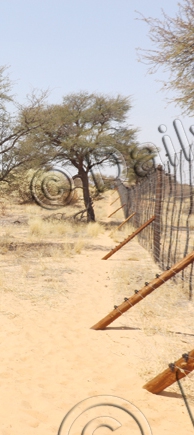Electric backline fence Effective buffer between wildlife human spaces
02 Oct 2024
A 30 kilometre electric and live back-line fence cuts between Mathathane ploughing fields and Tuli Block wildlife management area.
Along the fence are some solar panels and energisers that fire electricity into the line to keep it live and shock animals back into their areas.
Clearly, it has managed to curtail movements from either side of it. Only humans can go across through the gazetted points.
Mountainous elephant dung and other animals’ droppings litter the eastern side of the fence, while on the west, expectedly, are droppings of the domesticated animals testimony to a disappointed lot that were barred from proceeding on-to either side of the fence.
Here and there, stones have been shoved in under the fence to close down holes that are apparently dug by some wild animals that refuse to be shackled by human interventions against exploiting their natural habitat.
This is an intervention that residents of Mathathane have arduously advocated for.
While agitating for such an intervention, some farmers were forced into folding up their farming activities and fled to the village where they surrendered to hunger while simultaneously seething with anger.
The elephants would reportedly ravage farmers’ crops and boreholes while presenting danger to human lives, after trampling upon the then normal fence with utter impunity.
Only the strangely brave would conquer their fears and face the jumbos while continuing with their farming activities despite the potential danger that con-stantly lurked over them.
Prior to the erection of the electric fence, Mathathane traditional leader, Kgosi Olgas Serumola, in an interview, was upbeat that Terra Conservancy Operations, which possesses vast experience in elephant and animal management, would succeed in erecting a barrier fence that would address his subjects’ concerns.
The community leader’s conviction was by backed by director of Terra Con-servancy Operations, Mr Jurgen Elbertse.
“This fence is a new design, a double fence and fully electrified and will prevent elephants from breaking the fence and major predators going through this fence. It will also stop cattle from damaging the fence and will have major effect on stopping the poaching activities in the area,” Mr Elbertse said in February 2021.
The fence is owned by the Department of Wildlife and National Parks (DWNP) but Terra Conservancy Operations funded the construction, provided the pro-ject management and paid for the shortfall of materials.
Before erection of the electric fence, a public private partnership between Terra Conservancy Operations (a Botswana operating company owned by Timbo Afrika Foundation in The Netherlands), DWNP and Mathathane community, wild animals roamed freely in the human spaces and birthed the human-wildlife conflict.
During the ground-breaking of the construction of the fence, the then portfolio minister, Ms Philda Kereng said that the fence was a direct response to the then Ministry of Environment, Natural Resources Conservation and Tourism’s national elephant management plan with emphasis on curbing human-elephant conflict.
She said that there would also be some systematic and regular maintenance of the fence to ensure it continued to provide the intended purpose for the next 20 years.
Terra Conservancy provided P3 million for direct costs of construction and an estimated P1.2 million for monitoring and fence maintenance for the next three years.
Since the fence was completed in 2022, its benefits are felt and enjoyed on ei-ther side of it by both the community and private landowners.
In a recent interview, chief wildlife warden overseeing Bobirwa area, Mr Se-tokinyana Nkau confirmed the benefits generated by the electric backline fence.
“Human-wildlife conflict, especially with the farmers, has significantly dropped. I can only remember one incident of sighting of elephant in the human space,” said Mr Nkau.
Although the fence is lauded for, amongst other things, curbing human-wildlife conflict, hindering poaching and barring livestock from entering private land, Mr Nkau noted that there were incidents where elephants out-manoeuvred cattle grid placed across the tarred road heading to Lekkerpot junction.
However, he explained that the problem has since been addressed by placing lights on the spots to scare elephants away at night.
“Those elephants that can be sighted around Motlhabaneng are not a big problem. We’ve actually contained them,” Mr Nkau said, adding that the elephants remained on the human spaces when the rest were driven out because they had young calves that could not cope with the speed at the time.
As for poaching, he said suspicion was rife that some of the people who were engaged during the erection of the fence could have been privy to how to circumvent the electric fence, as there were some sporadic incidents where the fence was cut.
Kgosi Serumola of Mathathane said they were aware of such incidents and has since called meetings to rebuke all those who could be involved.
He said that he, too, was aware of reported sporadic incidents of poaching and cutting of fence.
Again, he was aware of the theft of the fence’s associated equipment, but has resultantly called on his morafe to own the fence and care for it.
Additionally, Kgosi Serumola said that he had tabled a proposal before senior chief representative, Kgosi Joel Masilo to have a 20men mophato to augment anti-poaching officers in patrolling the fence.
That way, as done along the borderline with Zimbabwe, chances of theft, poaching and destruction of fence, either by animals or humans, could be eliminated. ENDS
Source : BOPA
Author : Manowe Motsaathebe
Location : BOBONONG
Event : feature
Date : 02 Oct 2024






